Compulsory closed-circuit TV recording at abattoirs consultation: summary of responses
Analysis of responses to our public consultation on introducing compulsory CCTV recording in Scottish abattoirs.
Responses to Individual Questions
Question 1 - Should CCTV recording in all areas of approved slaughterhouses in Scotland where live animals are present be compulsory? Please give reasons for your response.
Table 3: Breakdown of respondent groups to question 1
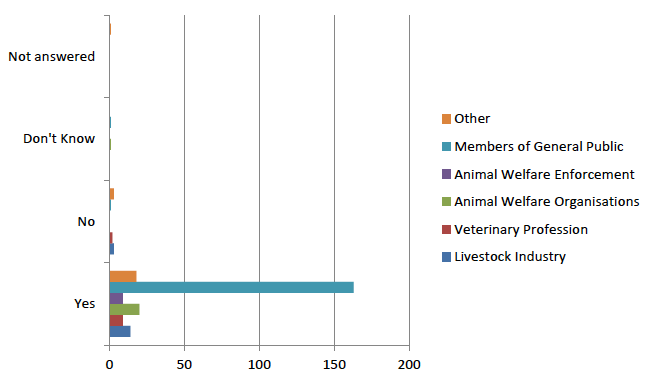
Of the 244 responses to this question, 95.1% were in favour of the introduction of compulsory CCTV recording in all areas of approved slaughterhouses in Scotland where live animals are present. 3.7% of respondents were against compulsory introduction and 1.2% did not express a view.
The Information Commissioner’s Office, responsible for promotion and enforcement of Data Protection regulations responded to the consultation but offered comments only, taking a neutral stance to all of the ‘yes/no’ questions. While the importance of monitoring and enforcement of animal welfare and reassuring customers was understood, it was considered likely that CCTV will capture personal details of individuals so fall within the scope of the Data Protection regulations. It was confirmed that workers can be monitored but processing of personal data needs to be proportionate and transparent and slaughterhouse staff and visitors need to be made aware of being filmed and of their data protection rights. Mandating CCTV in slaughterhouses as a proportionate response about animal welfare standards in slaughterhouses could represent a justifiable interference in the privacy of individuals under Article 8 of the European Convention on Human Rights; but the Scottish Government must ascertain this and conduct a human rights impact assessment. Data controllers, the slaughterhouse owners and operators, will also need to comply with the General Data Protection Regulation (EU) 2016/679.
The livestock industry (slaughterhouse operator, livestock and meat industry, retailer) responses were generally in favour (82.3%) of compulsory CCTV recording. However, two representations from small slaughterhouses considered this unnecessary as an official veterinarian is present at all stages of live animals being at their premises; and one food business operator considered there to be no greater risk to animal welfare in a lairage as opposed to an auction market or collection centre.
All other respondents from the livestock industry agreed the proposition of compulsory CCTV recording with the Scottish Association of Meat Wholesalers cited the “high level of public interest” as the reason for CCTV to “complement the current supervisory arrangements” and the National Farmers Union Scotland suggesting “flexibility over the type of system employed” to assist smaller abattoirs with installation.
No respondent from the animal welfare enforcement and organisation groupings was against compulsory CCTV recording. A number of reasons for this support were presented, many being similar to CCTV being seen as a “relatively low cost safeguard to animal welfare” (Aberdeen City Council), being able to monitor areas in slaughterhouses “after business hours” e.g. to supervise deliveries and unattended “lairages that are opened to the public” (Individual), and as a “useful additional tool” (Food Standards Scotland). A number of responses from animal welfare organisations, and from members of the general public, referenced the output from covert filming at slaughterhouses. They suggested that the incidents filmed might not otherwise have become known and that this evidenced the need for CCTV to be installed in all slaughterhouses and monitored by the authorities and management. The benefits of CCTV monitoring suggested by many animal welfare organisations included a reduction in malpractice, aiding investigation and prosecution of incidents (with FSS suggesting audio recording in addition to video), and opportunities for staff training and refining and developing slaughterhouse operations.
Respondents from the veterinary profession were generally in favour of compulsory CCTV recording (90.9%); although two respondents considered that smaller abattoirs where an official veterinarian is in place at all parts of the slaughter process should be granted exemption. The veterinary respondents also noted benefits, from CCTV use, to animal welfare, staff training, food safety and public health; and one respondent suggested a need for legislation ensuring access to footage at any time.
The BVA, VPHA and AGV [1] supported CCTV in all areas where live animals are present, but only as a complement to the “current physical monitoring and controls official veterinarians undertake”. BVA, VPHA and AGV also suggested that poorly positioned, low quality CCTV systems could “impede, as opposed to enhance” monitoring of compliance with animal welfare requirements. Consequently, these organisations contended that an agreed standard, admissible as evidence in a court of law, would be required and that CCTV should be installed to provide clear, unobstructed recording allied to a maintenance protocol ensuring image quality at all times.
While three responses from members of the general public were against compulsory CCTV from the viewpoint that animals should not be killed for food, the other 98% of responses from this group were in favour of the introduction of compulsory CCTV recording in all areas of a slaughterhouse where live animals are present. Just under a third of respondents from the ‘Public and Other’ groupings (59 of 187) cited the need to ensure animal welfare in light of the press reports on convictions of slaughterhouse operators and staff and of the covert filming carried out by animal welfare organisations. Many of the responses suggested a lack of trust in the proper treatment of animals in abattoirs. It was suggested by others that consumer confidence and animal welfare would increase with the introduction of compulsory CCTV recording.
Question 2 - Have we identified the main potential animal welfare gains from CCTV in slaughterhouses? Please give any other potential animal welfare gains.
Table 4: Breakdown of respondent groups to question 2
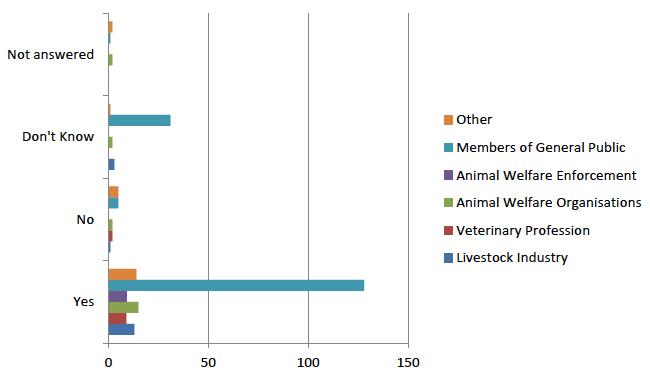
Of the 240 responses to this question, 78.3% considered that the main potential welfare gains were identified in the consultation document. 6.3% of respondents did not consider the main welfare gains had been identified and 15.4% did not express a view.
The consultation document noted the following main benefits of CCTV to the provision and enforcement of animal welfare in slaughterhouses:
- Full coverage and protection for live animals;
- Improved compliance with animal welfare at slaughter requirements;
- Detection of animal welfare breaches informing improved future practice and enhanced training and development for slaughterhouse staff;
- Authenticity and transparency of evidence of alleged wrongdoing;
- Improved observation of animal behaviour in areas dangerous or inaccessible to people;
- Improved efficiency and monitoring of enforcement activity.
Respondents from the veterinary and animal welfare enforcement sectors agreed the benefits of CCTV use but suggested that there remained a need for the physical presence and controls of an official veterinarian to protect animal welfare. Whilst CCTV was not considered as a “panacea to help prevent poor animal welfare standards” (BVA, VPHA, AGV) those veterinary organisations felt it should be “considered as an additional management tool to protect animal welfare, complementing robust veterinary supervision”.
The pressure that the presence of an official might place on slaughterhouse workers was also mentioned and it was considered that the “ability to view staff working without being present means that they can be observed working normally” (Food Standards Scotland) which could permit areas of poor practice to be identified and provide an opportunity for compliance to be improved through education.
One respondent from the veterinary profession considered that the assessment of the benefits had not taken account of the “much smaller island premises where slaughter is a one or two person operation and the official veterinarian can be present at the different stages” of slaughter process which are carried out in sequence following the arrival of the animals at the slaughterhouse. (Southern Isles Veterinary Practice)
Nourish Scotland commented that, while there is room for improvement in slaughterhouse practice, it is important that any legislation to promote animal welfare at slaughter should “start from the assumption that management and staff want to treat animals well and professionally”.
Another suggested welfare gain was the potential for horses, or other species not habitually killed at approved slaughterhouses in Scotland, to be “slaughtered as close to the point of origin as possible” and removing the need for lengthy transport to slaughter. (World Horse Welfare)
An individual response also suggested that mandatory CCTV coverage might also improve the “health and safety of workers” through reviewing work accidents and putting “prevention measures in place for the future” to stop them recurring. (Anonymous)
Another individual response cited paragraph 58 of the Farm Animal Welfare Committee’s report of February 2015 in relation to CCTV allowing “retrospective assessment … could lead to ‘better provision … for the behavioural needs of the animal waiting for slaughter’ and thus lead to ‘improved handling of the animals’” (Individual). A related comment by another individual suggested that CCTV footage might be used as a research tool discerning whether “different animals and different breeds may react differently to the slaughterhouse process” (Individual).
A small number of individual responses to this question were viewed from the approach that the slaughter process could not benefit the animals and that “welfarism is a myth in the context of CCTV” (Individual). Another individual voiced uncertainty about the benefits on the basis that “this proposal is only linked to animals for human consumption”, feeling that animals killed outwith approved slaughterhouses also face risks to their welfare. (Individual).
Question 3 - Is it reasonable to require Food Business Operators to retain CCTV footage for 90 days? Please give reasons for your response.
Table 5: Breakdown of respondent groups to question 3
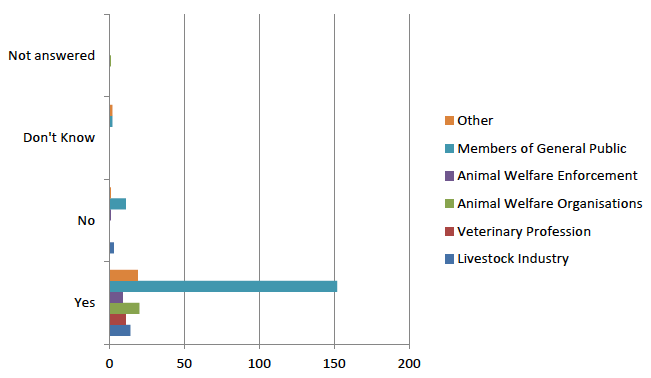
Of the 244 responses to this question, 92.2% considered it reasonable for Food business operators to be required to retain CCTV footage. 6.1% of respondents did not consider this to be reasonable and 1.6% did not express a view. However, 55 respondents (22.5%) commented that a retention period of 90 days should be a minimum statutory requirement.
Respondents from the veterinary and animal welfare enforcement sectors considered that 90 days would allow sufficient time for footage to be reviewed and not be destroyed before potential “use as productions and to support non-court interventions e.g. warning and statutory notices” (Perth and Kinross Council). It was also commented that retention of CCTV footage could also help “identify where problems occur – if an animal is hurt in transit, it is not the abattoir’s fault” (Argyll and Bute Council).
The BVA, VPHA & AGV joint response noted that a 90 day retention period would be in line with the recommendations of the Farm Animal Welfare Committee and the requirements of “several large retailers and the RSPCA Freedom Foods quality assurance scheme”. The joint response also suggested that if there was an indication that the footage might be used as evidence in enforcement action then it should be retained for a longer period.
Some responses from this sector also commented that a 90 day retention period would be “useful to identify behavioural trends in non-compliant premises” (Food Standards Scotland) and whether “any incidents have occurred as a one-off or as a pattern of behaviour” (Individual). The animal welfare organisation Animal Aid also commented that retained footage could be used for these same purposes.
Further points made by animal welfare organisations included OneKind’s recommendation that provision should be “made within the regulations” to allow longer-term retention where footage is being used “as part of an ongoing investigation or prosecution”. World Horse Welfare suggested that legislation should also “outline the responsibilities of the FBO to ensure they have adequate systems in place to effectively store and back-up large volumes of data”. Scotland for Animals replied that “devices should be tamper-proof and capture images of a standard sufficient to satisfy a Procurator Fiscal”.
The Information Commissioner’s Office responded that data retention should be dependent on the purpose of its collection and that retention should be set out in law to “provide a clear rationale for businesses to retain and dispose of footage containing personal data” and that such legislation should permit a longer retention period in certain cases.
The livestock industry sector (slaughterhouse operator, livestock and meat industry, retailer) was also in majority agreement (82.3%) with the proposal for a 90 day retention period, although this was qualified by the Scottish Association of Meat Wholesalers on the proviso that “the Food Business Operator has sufficient storage capacity on site”.
Negative responses from the livestock industry sector centred on the smaller abattoirs with Lochmaddy Slaughterhouse replying that such businesses “have more than enough to keep track of as it is without adding more work”.
Responses from individual members of the public were broadly in agreement with the responses noted above in favour of retention of footage. Additional comments by individuals included:
- “If this data is stored onsite should there be duplicates off-site?” (Anonymous)
- A suggestion that the retention period might be “different depending on the amount of animals they deal with in each place” (Individual)
- Retained CCTV footage “also protects companies and personnel from accusations” (Anonymous).
Question 4 - Should there be unrestricted access to CCTV footage, both real time and stored, for reasons of ensuring animal welfare by officers authorised by the Scottish Ministers? Please give reasons for your response.
Table 6: Breakdown of respondent groups to question 4
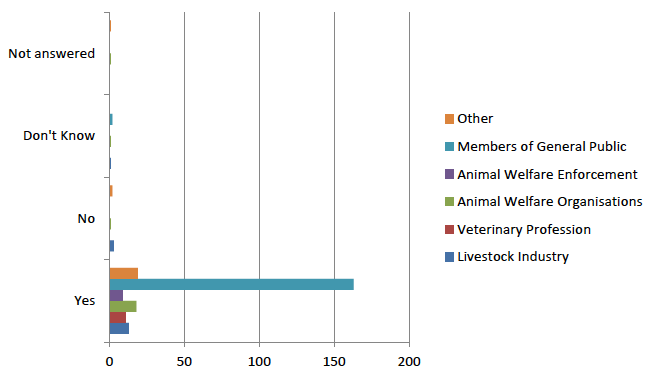
Of the 242 responses to this question, 95.9% were in favour of unrestricted access to CCTV footage, both real-time and stored, by officers authorised by the Scottish Ministers. 2.5% of respondents opposed unrestricted access to CCTV footage and 1.6% did not express a view.
There were only 6 respondents who considered that unrestricted access should not be provided to officers authorised by the Scottish Ministers – 2 from the livestock industry, 1 animal welfare organisation and 3 individuals. However, these expressed concern over who should have an unrestricted right to access CCTV footage rather than denying access itself.
The response from the animal welfare organisation was from the perspective of limiting access to those staff with a direct enforcement need, commenting that “free access by all Food Standards Scotland staff might well be opposed and suggest that access be limited, at least initially, to the official veterinarian and/or senior meat inspector” (Humane Slaughter Association). Similar comments came from two of the livestock industry respondents with the National Farmers Union Scotland (NFUS) suggesting that “any organisation that has a campaigning or lobbying role should not be permitted to see footage directly” but should instead inform Official Veterinarians who could review the footage to investigate concerns. NFUS do not, however, favour Official Veterinarians having full access to footage and suggested that “where an OV was present and carried out their required checks, with no reports or suspicions, they should not then spend further time analysing footage looking for breaches that they may have missed”.
The overwhelming majority in each group of respondents to the consultation agreed the animal welfare benefits that would accrue from unrestricted access by officers authorised by the Scottish Ministers being able to access footage from all areas where live animals are present; noting that this would improve opportunities to assess compliance with welfare at slaughter regulations on a proactive and reactive level.
There were, however, a number of suggestions around whether other organisations should be granted access in addition to Food Standards Scotland as the official regulator. While People for the Ethical Treatment of Animals were suggested by another organisation, their own response suggested that they accept that the current regulators are appropriate – “unrestricted access to real-time CCTV footage would allow FSS officials to monitor animal welfare in abattoirs actively during operational hours”. World Horse Welfare also considered that “CCTV footage should only be available to management and officials of Food Standards Scotland or the local authority”.
Suggestions as to whom the Scottish Ministers might also grant access rights included:
- “we would urge the Scottish Government to set up an external independent body to oversee the monitoring of footage” (Animal Aid and 20 individual responses based on the comments from that organisation)
- “Ministers should appoint authorised persons on the advice of People for the Ethical Treatment of Animals or the Farm Animal Welfare Committee” (Catholic Aid for Animals)
- OneKind assumed that authorised officers would include Official Veterinarians, local authority animal health and welfare officers and slaughterhouse animal welfare officers. In addition, OneKind recommended “the authorisation of all inspectors currently authorised under the Animal Health and Welfare (Scotland) Act 2006 to ensure that Scottish SPCA Inspectors are also empowered”.
- The Scottish Association of Meat Wholesalers favour unrestricted access to CCTV footage “provided the officers so authorised by the Scottish Ministers are suitably qualified and experienced veterinarians who understand the different behavioural characteristics that livestock can demonstrate within the slaughterhouse environment”.
The Information Commissioner’s Office noted that “access to the personal data on the CCTV recordings should be limited to authorised persons” and that only those with a justifiable need in relation to a statutory purpose have such access. The Commissioner also provided useful information on aspects of data protection that would need to be considered when any revisions are made to legislation granting access to CCTV for any purpose.
Question 5 - What do you think the cost of introducing compulsory CCTV in slaughterhouses in Scotland would be to (a) individual slaughterhouses and (b) to the Scottish slaughter industry as a whole? Please provide evidence to support your response.
The consultation document noted that specific questions on the costs of CCTV were being asked of the livestock and meat industries to inform any future Business Regulatory Impact Assessment on the introduction of compulsory CCTV.
This question attracted 204 responses in total; but no clear picture emerged from the responses. 76 respondents noted either an uncertainty of costs or an unwillingness to speculate. Of the remaining 128 responses, a small number assigned no numerical value, instead commenting similarly to individual responses which considered “the costs of not doing it is a lack of trust and transparency. Costs should be passed on to consumers” (Individual) and “whilst the financial costs are not large to either individual houses or the industry as a whole, the moral and ethical cost of not introducing compulsory CCTV would be huge” (Individual). The view that the animal welfare and other benefits outweighed any necessary cost of CCTV, considered by many to be minimal to business, was expressed by the majority of animal welfare, general public and veterinarian respondents.
The 17 responses from the livestock industry (slaughterhouse operator, livestock and meat industry, retailer) produced only three estimates of costs: these being “£3,000 to £5,000 per slaughterhouse” (Tayforth Machinery Ring), “£3,500 to £25,000 depending on size” (Anonymous) and “we would hope that a system could be introduced to cover multiple area for between £10,000 and £15,000” (Smallholding Scotland). The respondents from island abattoirs both suggested that any further expense would have an adverse impact on those types of business and could result in closure for such businesses.
The Scottish Association of Meat Wholesalers commented that costs would vary depending on size and layout and considered it “imperative that a consistent and uniform approach to CCTV installation is taken by authorised officials”.
Food Standards Scotland considered that the suggested installation costs in the consultation document might be an underestimate and that slaughterhouse operators could face additional cost because rectifying quality and access issues might “mean that systems would need a degree of sophistication to make the CCTV useful”. Food Standard Scotland also considered that it would face additional costs itself from “new approval and additional ongoing audit and assurance activities for authorised officers” and also from reviewing the Business Agreements that they have with slaughterhouses.
Question 6 - Do you consider that the costs of introducing compulsory CCTV in Scottish slaughterhouses are reasonable and proportionate for individual businesses irrespective of size? Please provide evidence to support your response.
Table 7: Breakdown of respondent groups to question 6
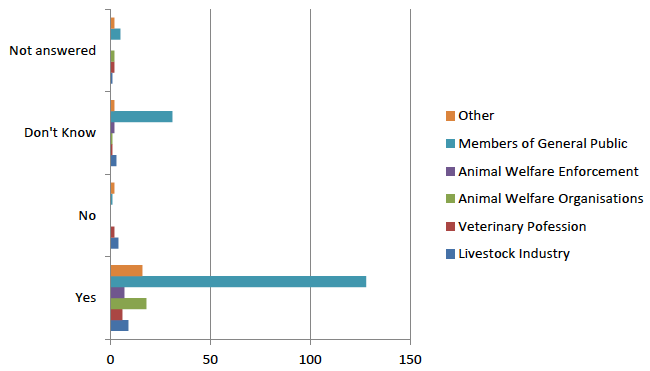
Of the 233 responses to this question, 79.0% considered the costs of introducing compulsory CCTV in Scottish slaughterhouses to be reasonable and proportionate for individual businesses irrespective of size. 3.9% did not agree that costs are reasonable and proportionate and 17.2% did not express a view.
Responses from the animal enforcement sector were almost unanimous in considering the costs to be reasonable and proportionate, recognising that costs of implementing new statutory requirements are “usually passed on, at least in part” (Anonymous). Two respondents from this sector considered that smaller and seasonally operating slaughterhouses may “struggle to meet the necessary costs” (Food Standards Scotland).
The responses from the veterinary sector were more mixed with 2 respondents suggesting “dispensation for small slaughterhouses with no compliance issues” (Anonymous) and that costs of introducing CCTV would “represent a much bigger expense relative to the business turnover” (Southern Isles Veterinary Practice). On the other hand, veterinary respondents considering the costs to be reasonable and proportionate viewed the introduction of CCTV as an “animal welfare and compliance issue, not a size issue” (Anonymous).
Responses from the animal welfare organisations were also almost unanimous in considering the costs to be reasonable and proportionate; however, the Humane Slaughter Association expressed uncertainty as it considered that the “costs set out in the impact assessment seem low”. A number of organisations (including Scottish SPCA and OneKind) pointed to the necessity for less equipment in smaller premises and the present existence of CCTV in the larger approved slaughterhouses was also cited by a number of respondents. Nourish Scotland considered that compulsory CCTV “is a case where exemption for small businesses is not justified”.
Just over half (9 of 17) of respondents identifying as from the livestock industry (slaughterhouse operator, livestock and meat industry, retailer) considered the costs to be reasonable and proportionate, whereas just under a quarter (4 of 17) did not agree that suggestion. While a number of those agreeing the proposition considered that “slaughterhouses can afford it” (Anonymous) and that “operators will marginally increase their costs” (Smallholding Scotland), some of those who did not consider the costs reasonable commented that ”there could be difficulties for the smaller abattoirs. They should be able to access simpler and cheaper options that work for them” (NFU Scotland).
Many individual respondents commented that cost could not be a justification for the non-introduction of mandatory CCTV with a number of comments similar to “CCTV is just a running cost and they should pay” (Individual); “some already have CCTV and only need a few additional ones” (Individual); “all businesses should be operating to the same standards of animal welfare regardless of size” (Individual); and that “smaller slaughterhouses will need fewer cameras at a lower cost” (Individual).
Question 7 - Are there any other economic benefits or costs not mentioned in the consultation document? Please explain what these might be and provide evidence to support your response.
Table 8: Breakdown of respondent groups to question 7
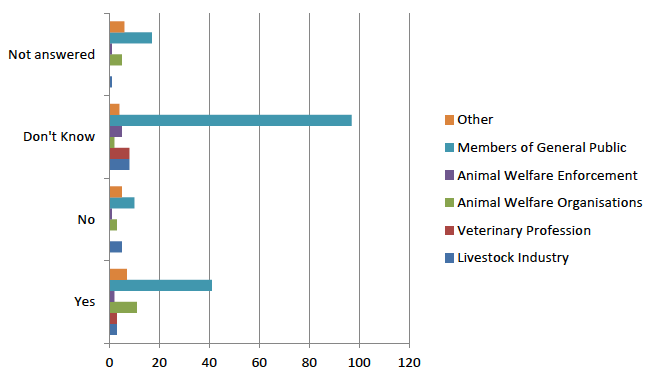
Of the 214 responses to this question, 31.2% considered there to be other economic benefits or costs that had not been mentioned in the consultation document. 11.2% considered that all of the costs or benefits had been mentioned in the consultation document and 57.7% did not express a view.
Additional Economic Benefits
Comments on benefits not mentioned in the consultation document included:
- “Enhanced security for businesses against criminal intrusion” and reduced costs of remote night-time monitoring of lairage (Perth & Kinross Council – Animal Welfare Enforcement);
- Increased revenue for businesses in the meat industry may accrue as “the mandatory presence in abattoirs with rigorous scrutiny would put a higher value on Scottish meat as having high welfare standards” and businesses might use CCTV footage to monitor and improve “staff performance and process efficiency” (Food Standards Scotland, Animal Welfare Enforcement). A number of members of the general public made similar comments e.g. “Demonstrating high welfare standards will enable Scottish meat to be marketed as a high quality product” (Anonymous);
- OneKind (Animal Welfare Organisation) considered that “animal welfare must be valued as a fundamental element of food quality” and that demonstrating compliance of legal requirements around slaughter may improve consumer confidence. More than a dozen other respondents also mentioned increased consumer confidence as a consequence of mandatory introduction of CCTV;
- Contribution to “better productivity, healthier products and safer working environments” (Humane Slaughter Association, Animal Welfare Organisation);
- “Enhanced food safety and enhanced value of animal welfare in promoting high quality food” (Individual); and
- One member of the general public suggested that CCTV coverage might also be used for purposes other than animal welfare and minimise the costs of “Health and Safety legal action against the employer and general legal action against the industry” (Anonymous).
Additional Economic Costs
Comments on economic costs not mentioned in the consultation document included:
- Obligations arising from the Information Commissioner’s Office such as payment of a registration fee and new costs associated with the “new data protection standards” of the General Data Protection Regulation of May 2018. (Food Standards Scotland, Animal Welfare Enforcement); and
- Slaughterhouses might be considered a less than ideal environment for electrical equipment and costs might be incurred from “providing effective maintenance and replacement, as well as updating system hardware when necessary” (Joint response from BVA, VPHA and AGV).
Question 8 - Should CCTV be installed in all approved slaughterhouses, regardless of size? Please provide justification for your response.
Table 9: Breakdown of respondent groups to question 8
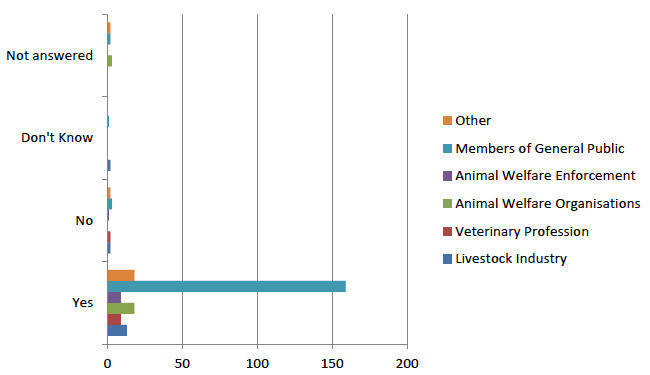
Of the 238 responses to this question, 94.9% supported the mandatory installation of CCTV in all approved slaughterhouses – with an overwhelming majority in each grouping. 4.2% of respondents opposed mandatory installation and 1.7% did not express a view.
The respondents from the livestock industry and the veterinary profession who did not seek compulsory CCTV for all slaughterhouses highlighted that smaller premises where there is a “vet present at all kills” (Lochmaddy Slaughterhouse) and this was supported by the veterinarian who officiates at that slaughterhouse reiterating that he had supervised “all stages of the operation and welfare has never been a concern” (Southern Isles Veterinary Practice). Whilst neither for nor against the proposal, NFU Scotland considered that CCTV may not be necessary “in cases where the OV can easily oversee entire processes”.
The majority of the respondents from the livestock industry and veterinary profession commented similarly to the views that “in order to demonstrate a high level of compliance with the animal welfare controls all approved slaughterhouses should install CCTV” (Scottish Association of Meat Wholesalers); “to ensure consistent enforcement and compliance of welfare standards, CCTV should be installed … regardless of size” (BVA, VPHA, AGV); and that “size makes no difference whatsoever to the problems that CCTV will help to eliminate” (Individual).
Responses from the animal welfare organisation and enforcement groupings were broadly similar with additional comments that “potential contraventions of the law are not related to the size of the business” (Argyll and Bute Council); Animal Aid considering that “exempting smaller business from any compulsory CCTV recording would undermine the overall effectiveness of a requirement” and Food Standards Scotland noting that it could “be argued that CCTV .. facilitates controls” in premises where Food Standards Scotland staff do not exert a permanent presence.
The Humane Slaughter Association suggested that there might be an unintended “net negative effect on animal welfare” resulting from increased travel distances to slaughter in the event of closure of some smaller premises brought on by the installation and running costs associated with CCTV installation. An anonymous individual respondent suggested that compulsory CCTV in all slaughterhouses might deliver a positive benefit whereby fewer animals unfit for travel might be transported if they could be identified on arrival at the slaughterhouse.
Responses from members of the general public reiterated the comments already reported on the size of the business being unrelated to the issue of animal welfare and that no business should be exempt from CCTV coverage as that would undermine the effectiveness of the measure. One individual suggested that CCTV could be most important for smaller premises as the smaller number of workers might make it less likely for suspicions of “abusing animals” to be reported (Individual).
Question 9 - Should the Scottish Government help smaller businesses to comply with a requirement for compulsory CCTV? Please provide justification for your response.
Table 10: Breakdown of respondent groups to question 9
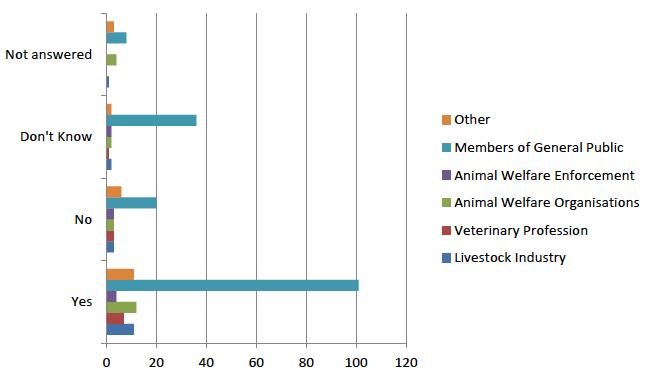
Of the 229 responses to this question, 63.8% replied that the Scottish Government should provide help for smaller businesses to install CCTV. 16.6% did not support Scottish Government assistance being provided and 19.6% did not express a view.
Respondents from the livestock industry were largely in favour (64.7%) of assistance being provided, with a number noting that the challenges faced by smaller abattoirs might be mitigated by providing grants to help with installation costs, offer technical advice or, as suggested by two respondents, wholly fund the introduction of CCTV in smaller premises. The Scottish Association of Meat Wholesalers offered to administer any support package on behalf of the Scottish Government although it considers the proposal is being made “to satisfy public demand rather than address non-compliance with the current welfare controls”.
Respondents from animal welfare organisations were less in favour (57.1%) of assistance being provided. Catholic Action for Animals viewed the question holistically in terms of environmental effects of meat production asking “why should the taxpayer help this wasteful, damaging system of farming?”; the Scottish SPCA noted that “slaughterhouses are commercial businesses and should bear the costs involved”; and Scotland for Animals suggested that “any costs should be met by a levy on the industry itself”.
Animal welfare organisations in favour of assistance noted the benefits of local abattoirs to animal welfare “as they prevent live transport” (British Horse Society), and OneKind agreed these benefits to also support assistance “if it helped to expedite installation of CCTV”.
The only grouping not providing a majority in favour of assistance was animal welfare enforcement (44.4%). Suggestions from this grouping included that any assistance provided should be means tested or be through advice and information only. Food Standards Scotland commented that the “standard definitions for micro and small businesses may not be effective in this context” but added that “consideration needs to be given to islands abattoirs”. The Humane Slaughter Association, in its response in favour of assistance, suggested that abattoirs with “an annual throughput of, say, below 1,000 livestock units should qualify for financial assistance”.
While 63.6% of respondents from the veterinary profession favoured assistance, the comments provided did not always support that view e.g. “in my opinion that would not be necessary and it should be accepted by slaughter house owners that cameras are a tool of the trade” (Individual) and suggesting that assistance might be “useful, in order to get ‘buy-in’ from the industry” (Individual). The BVA, VPHA & AGV joint response suggested that those organisations would “welcome the provision of a support scheme” for small businesses “to cover some of the associated expenditure necessary to install, maintain and train staff to appropriately use a CCTV system”
59.9% of respondents from the general public and other groupings supported assistance being provided. However, there was a strong undercurrent that any costs would be modest and proportionate, viewed as legitimate costs of business and that loans should be offered to smaller businesses instead of grants. A number of individuals in favour of assistance also commented on the welfare benefits of slaughter close to the point of production.
Contact
There is a problem
Thanks for your feedback